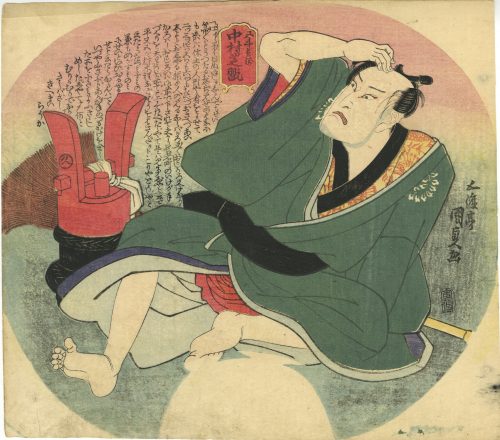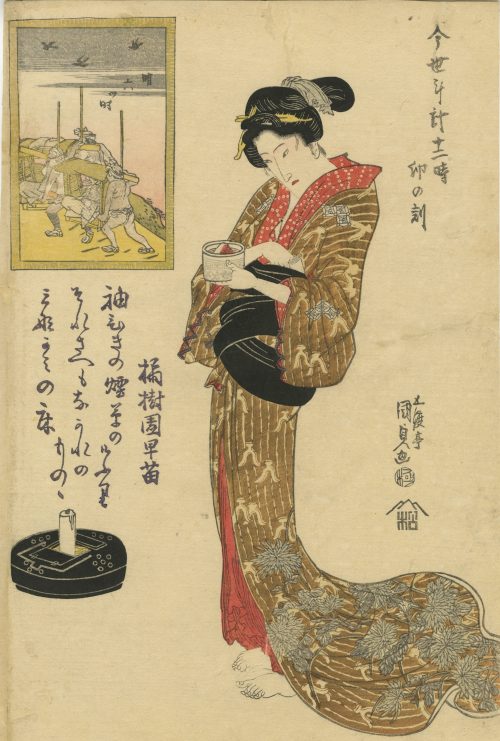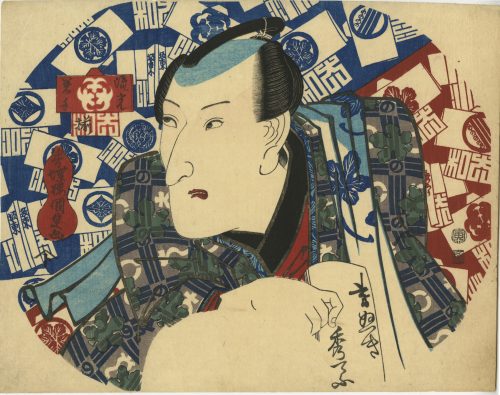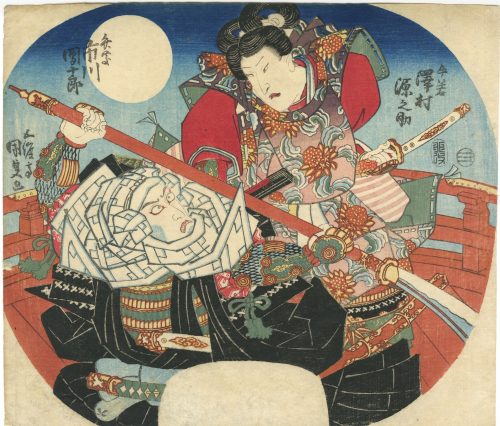 Horst Graebner also noted that the performance took place at Nakamura Theatre in Edo on Bunsei 13/03 (03/1830) (see Waseda University Cultural Resources Database # 100-4224):
Horst Graebner also noted that the performance took place at Nakamura Theatre in Edo on Bunsei 13/03 (03/1830) (see Waseda University Cultural Resources Database # 100-4224):

Toyokuni II

 Horst Graebner also noted that the performance took place at Nakamura Theatre in Edo on Bunsei 13/03 (03/1830) (see Waseda University Cultural Resources Database # 100-4224):
Horst Graebner also noted that the performance took place at Nakamura Theatre in Edo on Bunsei 13/03 (03/1830) (see Waseda University Cultural Resources Database # 100-4224):

Toyokuni II



 Uncut fan print (uchiwa-e) depicting Onoe Kikugorō IV as Karukaya Dōshin parting from his son, Ishidomaru (played by Ichimura Uzaemon XIII), and Kawarasaki Gonjūrō I as Yamazakiya Yogoro in the kabuki play Karukaya Dōshin Tsukushi no Iezuto [苅萱桑門筑紫𨏍], written by Namiki Sōsuke [並木宗輔] (Japanese, 1695 – 1751) and performed at Ichimuraza [市村座] in 05/1856.
Media: Fan print [団扇絵] (Uchiwa-e); size: 235 x 305 mm.
Actors:
Onoe Kikugorō IV [四代目 尾上菊五郎] (Japanese, 1808 – 1860); other names: Onoe Baikō IV, Onoe Eizaburō III, Onoe Kikue, Nakamura Tatsuzō, Nakamura Kachō.
Onoe Kikugorō V [五代目尾上菊五郎] (Japanese, 1844 – 1903 other names: Onoe Baikō V, Ichimura Kakitsu IV, Ichimura Uzaemon XIII [十三代目市村羽左衛門], Ichimura Kurōemon.
Ichikawa Danjūrō IX [市川団十郎] (Japanese, 1838 – 1903); other names: Kawarasaki Sanshō, Kawarasaki Gonnosuke VII, Kawarasaki Gonjūrō I, Kawarasaki Chōjūrō III.
Plot: It was a popular belief at one time that jealous women had their hair transformed into writhing serpents and Kato Sayemon Shige-Uji, a daimyo of Tsukushi, a much-married man, suffered from the delusion that his wife was so affected. He fled to the mountains to escape her and led the life of a hermit under the name of Karukaya Doshin [苅萓道心]. One day, on Mount Kōya (高野山, Kōyasan) Karukaya meets a young man who was wandering in the mountains. Being questioned, the youth tells his name, Ishidomaru, and elicits the information that he is seeking his lost father. Karukaya then recognizes the boy as his own son, but firm in the resolve to remain lost to the world, he refrains from disclosing himself, and bids the youth return home.
Provenance: Paul F. Walter (American, 1935 – 2017).
Ref.:
Uncut fan print (uchiwa-e) depicting Onoe Kikugorō IV as Karukaya Dōshin parting from his son, Ishidomaru (played by Ichimura Uzaemon XIII), and Kawarasaki Gonjūrō I as Yamazakiya Yogoro in the kabuki play Karukaya Dōshin Tsukushi no Iezuto [苅萱桑門筑紫𨏍], written by Namiki Sōsuke [並木宗輔] (Japanese, 1695 – 1751) and performed at Ichimuraza [市村座] in 05/1856.
Media: Fan print [団扇絵] (Uchiwa-e); size: 235 x 305 mm.
Actors:
Onoe Kikugorō IV [四代目 尾上菊五郎] (Japanese, 1808 – 1860); other names: Onoe Baikō IV, Onoe Eizaburō III, Onoe Kikue, Nakamura Tatsuzō, Nakamura Kachō.
Onoe Kikugorō V [五代目尾上菊五郎] (Japanese, 1844 – 1903 other names: Onoe Baikō V, Ichimura Kakitsu IV, Ichimura Uzaemon XIII [十三代目市村羽左衛門], Ichimura Kurōemon.
Ichikawa Danjūrō IX [市川団十郎] (Japanese, 1838 – 1903); other names: Kawarasaki Sanshō, Kawarasaki Gonnosuke VII, Kawarasaki Gonjūrō I, Kawarasaki Chōjūrō III.
Plot: It was a popular belief at one time that jealous women had their hair transformed into writhing serpents and Kato Sayemon Shige-Uji, a daimyo of Tsukushi, a much-married man, suffered from the delusion that his wife was so affected. He fled to the mountains to escape her and led the life of a hermit under the name of Karukaya Doshin [苅萓道心]. One day, on Mount Kōya (高野山, Kōyasan) Karukaya meets a young man who was wandering in the mountains. Being questioned, the youth tells his name, Ishidomaru, and elicits the information that he is seeking his lost father. Karukaya then recognizes the boy as his own son, but firm in the resolve to remain lost to the world, he refrains from disclosing himself, and bids the youth return home.
Provenance: Paul F. Walter (American, 1935 – 2017).
Ref.:


 SVJP-0179-6.2014 |
The Hour of the Dragon, Fifth Hour of Day (Tatsu no koku, Hi no itsutsu toki), from the series Twelve Hours of a Modern Clock (Imayo tokei jūniji) 「今世時計十二時 辰ノ刻 日ノ五つ時」 MFA impression: 11.15315. |
 SVJP-0179-1.2014 |
The Hour of the Rabbit, Sixth Hour of Day (U no koku, Ake muttsu toki), from the series Twelve Hours of a Modern Clock (Imayo tokei jūniji) 「今世時計十二時 卯ノ刻 明六つ時」. MFA impression: 11.15317 |
 SVJP-0179-2.2014 |
The Hour of the Monkey, Seventh Hour of Day (Saru no koku, Hi no nanatsu toki), from the series Twelve Hours of a Modern Clock (Imayo tokei jūniji) 「今様時計十二時 申ノ刻 日ノ七つ時」 MFA impression: 11.39692 |
 SVJP-0179-8.2014 |
The Hour of the Horse, Ninth Hour of Day (Uma no koku, Hi kokonotsu toki), from the series Twelve Hours of a Modern Clock (Imayo tokei jūniji) 「今世時計十二時 午ノ刻 日九つ時」. MFA impression: 11.15314 |
 SVJP-0179-4.2014 |
The Hour of the Boar, Fourth Hour of Night (I no koku, Yoru yottsu toki), from the series Twelve Hours of a Modern Clock (Imayo tokei jūniji) 「今世時計十二時 亥ノ刻 夜四つ時」. MFA impression: 11.15552 |
 SVJP-0179-3.2014 |
The Hour of the Tiger, Seventh Hour of Night (Tora no koku, Yoru nanatsu), from the series Twelve Hours of a Modern Clock (Imayo tokei jūniji) 「今世時計十二時 寅ノ刻 夜七つ」. MFA impression: 11.15313 Ref.: Izzard. Kunisada’s world [LIB-2970.2022]. |
 SVJP-0179-5.2014 |
The Hour of the Ox, Eight Hour of Night (Ushi no koku, Yoru no yattsu toki), from the series Twelve Hours of a Modern Clock (Imayo tokei jūniji) 「今世時計十二時 丑ノ刻 夜ノ八つ時」. MFA impression: 11.26906 |
 SVJP-0179-7.2014 |
The Hour of the Rat, Ninth Hour of Night (Ne no koku, Yoru kokonotsu toki), from the series Twelve Hours of a Modern Clock (Imayo tokei jūniji) 「今世時計十二時 子ノ刻 夜九つ時」. MFA impression: 11.15312 |









Uncut fan print (uchiwa-e), 295 x 230 mm, depicting kabuki actor Bandō Shūka I as Shirai Gonpachi (白井権八) reading a scroll by the light of a lantern. From the series A Parody of the Five Chivalrous Commoners; a Cup of Sake From Their Fans (Mitate gonin otoko, go-hiiki no omoizashi). According to Paul Griffith, the term omoizashi refers to the act of pouring a cup of sake for one's chosen partner, here giving an impression of intimacy and affection between famous actors and their patrons.
Actor: Bandō Shūka I [初代坂東しうか] (Japanese, 1813-1855); other names: Bandō Tamasaburō I, Bandō Mitsugorō V (posthumously). The print was probably published by some unknown Yama-Ta (Marks U421b). Double nanushi censor seals and date seal: Muramatsu and Fuku, Kaei 5, 2nd month (2/1852). As Kabuki Encyclopedia put it: "Gonpachi. A parasite. From the character named Shirai Gonpachi who lives at the home of Banzui Chōbei and sponges off him" (An English-Langauge Adaptation of Kabuki Jiten. Samuel L. Leiter. Greenwood Press, 1979, pp. 26, 98-9). There were many kabuki plays based on the story of the lovers Miura-ya Komurasaki and Shirai Gonpachi. (See: [LIB-2226.2019] Algernon Bertram Freeman-Mitford. Tales of Old Japan. — London: Macmillan and Co., 1883). Ref.: Art shop Ezoshi Ukiyoe new collection news, vol. 66, 2023.1 (Jan) # 31, p.8.






Robert Schaap, 2016.





Promotional fan for a hairpin shop, with a poem by Ichikawa Danjuro VII, signed Hakuen.
Date seal plus rectangular kiwame seal: Bunsei 8 (1825).
Size: Fan print. Uchiwa-e (27.5 x 21.1 cm) Publisher seal: Maru-To (2) (Marks U204). Date seal plus rectangular kiwame seal: Bunsei 8 (1825).


